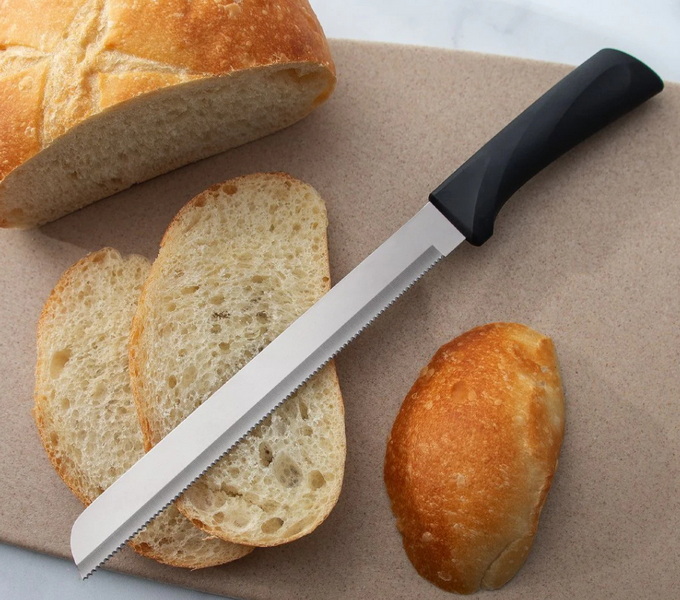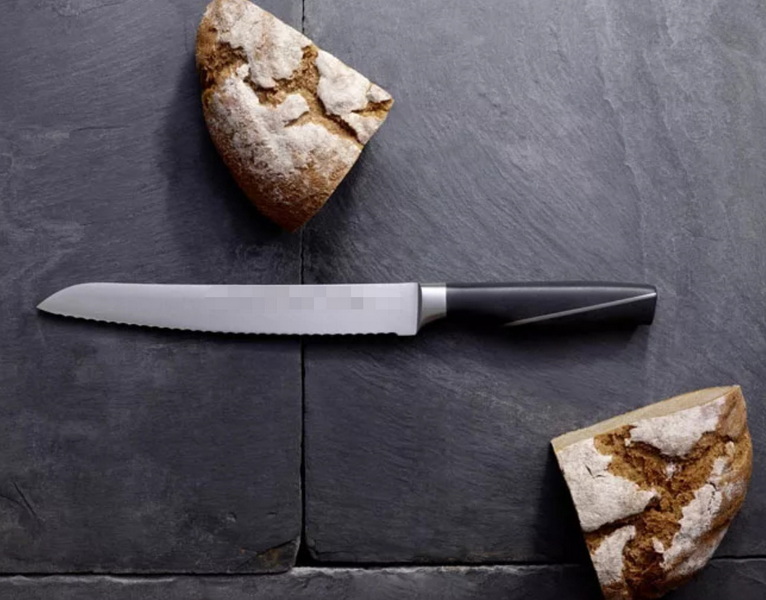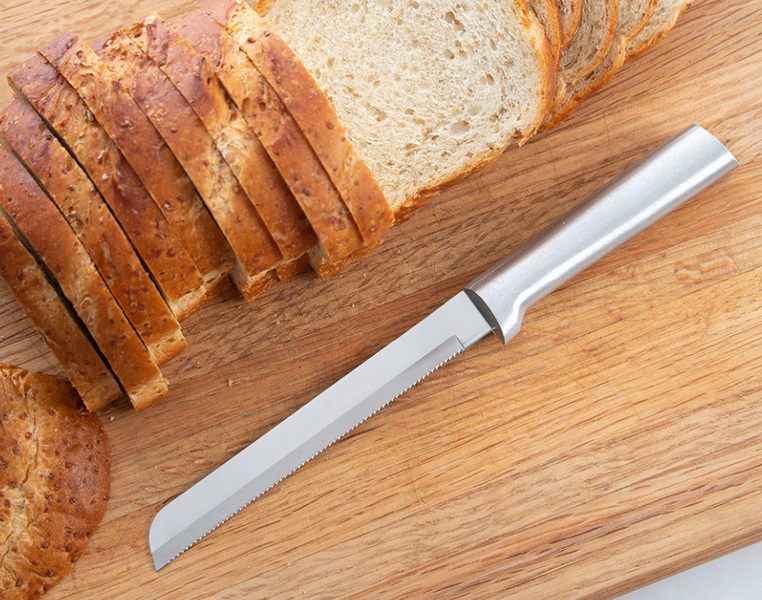- All
- Product Name
- Product Keyword
- Product Model
- Product Summary
- Product Description
- Multi Field Search
Views: 222 Author: Ann Publish Time: 2025-11-07 Origin: Site











Content Menu
● Key Attributes That Define Quality Bread Knives
● Tooth pattern and edge retention
● Handle ergonomics and balance
● Tang design and overall construction
● Manufacturing precision and quality control
>> Heat treatment and tempering
>> Machining, grinding, and finishing
>> Coatings and non-stick technologies
>> Handle attachment and ergonomics
● Usage scenarios and practical testing
>> Domestic use
>> Commercial kitchens and bakeries
● Materials science deep dive for Bread Knife
>> Coatings and their implications
>> Ergonomics and user experience
● OEM opportunities and value proposition
>> Certifications and compliance
>> Case studies and how to evaluate
● Maintaining leadership in Bread Knife quality and OEM service
● FAQ
>> What material is best for Bread Knife blades?
>> How does serration affect cutting crust vs crumb?
>> What makes a Bread Knife ergonomic?
>> How to evaluate edge retention and durability?
>> How can OEM partners support international buyers?
Bread knife plays a crucial role in professional kitchens, bakeries, and home baking alike. A high-quality Bread Knife should deliver clean, effortless slices, maintain its edge through repeated use, and feel balanced and comfortable in hand. For OEM manufacturers and foreign brands, distinguishing premium bread knives from cheaper imitations hinges on material science, manufacturing precision, ergonomic design, and proven quality controls. This article provides a comprehensive guide to identifying a high-quality Bread Knife, emphasizing the key indicators and practical testing methods that buyers, distributors, and OEM partners can rely on. By understanding these aspects, OEM teams can better specification-match customer requirements, assure consistent batch quality, and communicate compelling value propositions to international buyers.

The blade length of a Bread Knife typically ranges from 8 to 10 inches (20 to 25 cm) for most residential and light commercial use. In professional settings, a slightly longer blade can improve leverage when slicing large loaves. The blade geometry—whether straight-edged or gently curved—affects slicing rhythm and crust separation. A high-quality Bread Knife maintains a consistent thickness along the blade, minimizing snagging and wobble across the loaf. The edge geometry should be designed to yield both long, continuous cuts and the ability to follow irregular bread shapes without tearing the crumb. These features directly influence user satisfaction and cutting efficiency in busy kitchens. The blade geometry and length are fundamental criteria for assessing Bread Knife quality and should be verified through careful inspection and practical testing.
Serration density and tooth shape are central to a high-performing Bread Knife. A well-engineered serration provides rigid, sharp teeth that grip crust without shredding crumb, while preserving edge integrity through repeated cuts. Overly aggressive serrations can crush crust and tear crumb, whereas too-fine serrations may dull quickly with dense crusts. The best Bread Knife uses a balanced serration pattern that suits common bread varieties (crusty sourdough, soft sandwich loaves, and rustic loaves). Edge retention reflects the steel's hardness and the quality of heat treatment, which enable the knife to maintain sharpness during daily bakery tasks and restaurant service. Regular sharpening should restore the edge without removing excessive material. Testing in real-world slicing scenarios is essential to confirm serration performance.
The combination of steel composition and any surface coatings defines durability, corrosion resistance, and ease of maintenance. High-quality Bread Knife blades are often crafted from stainless steel alloys with balanced hardness and toughness, or from high-carbon stainless steels that tolerate sharpening without becoming brittle. Some premium models incorporate specialty coatings to reduce food sticking and to ease cleaning, potentially extending edge life. When evaluating a Bread Knife, verify the steel grade, corrosion resistance, and any coating claims against actual performance during wet and acidic food handling. Rigorous QC records should accompany material data sheets (MDS) for traceability.
A comfortable handle reduces fatigue during long service periods and improves control, especially in high-volume bakery environments. The handle material should provide a secure grip, washing resistance, and non-slip properties when wet. Balance point—the location where the knife's weight feels evenly distributed—significantly influences cutting comfort. A well-balanced Bread Knife feels like an extension of the hand, enabling precise strokes with minimal wrist strain. For OEM projects, offering customization options for handle shape, material (e.g., PEEK, polymer composites, or wood), and color can create differentiation in crowded markets.
A full or partial tang enhances strength and stability, contributing to durable assembly under frequent use. The connection between the blade and the handle should be seamless, with no gaps, cracks, or looseness that could compromise safety or performance. The finishing quality—polish, burr removal, and corner radii—also impacts user perception of premium grade. A Bread Knife with robust construction supports consistent performance across dozens or hundreds of slices daily, a critical factor for professional buyers evaluating OEM suppliers.
Premium bread knives begin with carefully chosen raw materials. Stainless steel alloys that offer a good balance of hardness, toughness, and corrosion resistance are common choices. For OEM projects, material certification and supplier traceability are important. Buyers expect documentation such as chemical composition, mechanical properties, and batch QC results to verify that every blade meets specified standards.
Hardness is a defining property for edge retention and durability. The heat treatment process—comprising heating, quenching, and tempering—transforms steel microstructure to achieve a stable, durable edge. Cryogenic treatment is sometimes used to improve carbide stability and hardness in some brands. A high-quality Bread Knife demonstrates a well-documented heat treatment regime aligned with the steel type, along with consistent hardness across production lots. OEM partners should provide process controls and test certificates to support long-term performance claims.
Blade shaping and surface finishing influence cutting efficiency and aesthetics. Precision CNC machining, controlled grinding, and meticulous deburring produce uniform edges that cut smoothly. Finishing processes—such as satin or mirror polish—also affect corrosion resistance and ease of cleaning. The presence of consistent burr removal and precise bevels is a hallmark of quality bread knives. For OEM buyers, evidence of calibrated equipment and standard operating procedures (SOPs) is essential to ensure reproducible results.
Serration creation requires precise tooling and consistent tooth geometry. Modern bread knife serrations can be ground using specialized wheels or laser-etching processes to achieve consistent tooth profiles along the blade length. The consistency of serrations correlates with performance on crusty bread and durability under repeated use. OEM suppliers should demonstrate QA checks for tooth geometry and edge sharpness across every blade.
Coatings can reduce crust sticking and simplify cleaning, contributing to longer blade life by reducing abrasive contact with crust. Titanium nitride (TiN) and other protective coatings can be applied to improve wear resistance. OEM partners should provide coating specifications, adhesion tests, and post-coating inspection results to verify coating integrity.
The relationship between blade and handle—whether through rivets, tamper-proof screws, or mechanical interlocks—must be secure. A well-attached handle resists loosening during heavy use and cleaning cycles. OEM factories typically document assembly processes, torque specifications for fasteners, and quality checks for joint integrity.

For home kitchens, a Bread Knife must offer reliable performance with occasional heavy use. Testing should include slicing a variety of crust types, soft sandwich breads, and dense artisanal loaves. Indicators of quality include smooth gliding action, minimal crumb tearing, and a comfortable grip that remains secure when wet. End-users value balance, edge retention, and ease of maintenance.
In professional environments, Bread Knife performance is tied to throughput, durability, and consistent outcomes. Tests should simulate high-volume bread slicing with frequent cleaning cycles, exposure to humidity, and contact with residual dough and enzymes. A high-quality Bread Knife demonstrates rapid edge recovery after sharpening and stable cutting performance across multiple loaves. OEM suppliers should highlight production controls that ensure batch-to-batch consistency, certifications (e.g., food safety standards), and scalable supply capabilities.[2][6]
Regular care preserves edge life and hygiene. Proper washing, drying, and storage reduce corrosion risk and prolong blade life. Guidance typically includes hand-washing rather than dishwasher cycles, thorough drying, and dry storage away from moisture. Sharpening routines—whether by sharpening steel, diamond whetstones, or professional services—should be described with recommended angles, grit, and frequency based on material and use. Clear maintenance instructions add credibility to any Bread Knife offering.
Austenitic stainless steels offer good corrosion resistance and ease of maintenance, though some grades balance flexibility and hardness. Martensitic stainless steels can achieve higher hardness, improving edge retention but potentially reducing toughness if not properly alloyed. OEM projects should specify the exact grade, along with heat-treatment profiles, to guarantee predictable performance.
High-carbon steels can sharpen to very fine edges but may require more vigilant corrosion control. When used for Bread Knife blades, proper coating and stainless compatibility may be employed to mitigate rust risk while maintaining sharpness. OEM partners often balance carbon content, alloying elements, and protective coatings to achieve a practical compromise between edge retention and corrosion resistance.
Non-stick or wear-resistant coatings can aid cleaning and edge protection but must be compatible with food safety standards and not impair cutting performance. Coatings should be tested for chipping, wear, and safe release of any particulates. For OEM customers, documentation on coating materials, adhesion tests, and post-application QA is essential to validate claims.
Designing for diverse hand sizes and grip textures increases usability in a global market. Ergonomic handle shapes can be customized to regional preferences, such as more rounded handles for comfort or angular profiles for aggressive control. For OEM collaborations, offering modular handle options or different materials can help meet customer expectations across markets.
OEM bread knife programs can include a range of blade lengths, serration patterns, grind types, handle materials, and packaging. Transparent collaboration on material sourcing, production lead times, and quality assurance creates trust with international brands. Demonstrating capabilities in private labeling, packaging design, and regulatory compliance strengthens competitive positioning.
Having a robust QM system with documented SOPs, process controls, incoming material inspection, in-process checks, and final inspection is critical. Certificates of conformity, product testing reports, and traceability records reassure buyers about consistency and safety. OEM suppliers should be prepared to share comprehensive QA documentation to support claims of reliability.
Food-contact compliance, metal safety standards, and branding requirements vary by region. OEM offerings should align with major markets (EU, US, UK, Asia) and provide evidence of compliance through test reports and third-party certifications where applicable. This reduces buyer risk and streamlines import processes.
Packaging and branding
Packaging should protect the Bread Knife during transit and clearly communicate features, care guidelines, and certifications. For OEM collaborations, branding opportunities include custom logo placement, packaging artwork, and insertion of care tips or recipe cards. Strong packaging supports a premium perception and reduces damage during distribution.
- Case study concept: A bakery chain seeks to replace a range of Bread Knife models with a single OEM partner who can customize blade length, serration pattern, and handle materials while maintaining consistent quality across lots.
- Evaluation criteria: Material certification, heat treatment traceability, edge retention tests, ergonomic assessments, and packaging customization options. The OEM partner's ability to provide rapid prototyping, pilot runs, and scalable production schedules is a plus. This demonstrates how a high-quality Bread Knife program can meet diverse market needs while ensuring uniform performance.
In today's global market, a Bread Knife that performs reliably across a wide range of breads and settings is a differentiator for any brand. For OEM teams, investment in material science, precision manufacturing, ergonomic design, and rigorous quality control yields long-term customer trust, repeat orders, and favorable pricing through efficiency. By combining technical excellence with responsive customer collaboration, a factory can offer Bread Knife solutions that satisfy both consumer expectations and international regulatory requirements. The emphasis remains on consistent performance, safe handling, and efficient support for private-label partners. This approach not only strengthens market position but also reinforces brand value across regions.
Identifying a high-quality Bread Knife requires evaluating materials, manufacturing precision, and ergonomic design, all backed by solid quality controls. For foreign brands and OEM clients, the capability to customize blade length, serration patterns, handle materials, coatings, and packaging—while maintaining strict traceability and certifications—defines true leadership in Bread Knife offerings. A reliable OEM partner should provide transparent data, robust QA documentation, and the agility to support pilot runs, samples, and scalable production to meet diverse international requirements. By focusing on the core attributes outlined above and leveraging a proven manufacturing platform, buyers can secure Bread Knife solutions that deliver consistent performance, longevity, and brand value in competitive global markets. Reach out to discuss private-label opportunities, sample programs, and tailored Bread Knife configurations that align with regional preferences and regulatory standards. This collaborative approach ensures successful market entry and sustained success for both manufacturers and brand partners.

High-quality bread knife blades often use stainless steel alloys or high-carbon stainless steels that balance hardness, toughness, and corrosion resistance.
Proper serration grips crust without crushing crumb; too aggressive or too fine patterns can cause tearing or dulling.
A comfortable, non-slip handle, balanced weight distribution, and secure blade-to-handle connection reduce fatigue during extended use.
Check hardness specifications, heat-treatment details, and real-world performance tests; OEM QA should provide test reports and batch traceability.
Through customization options, private labeling, packaging design, certifications, pilot runs, and reliable lead times.
The Ultimate Professional Knives for Halal Butchery in Middle Eastern Kitchens
Chef Knife Size Guide: Choosing Between 6″, 8″, 10″, And 12″
Custom Knife Handles: How To Design A Chef Knife That Fits Your Hand Perfectly
Chef Knife Surface Treatments Guide: From Polished Migaki To Damascus Patterns
Inside Our Professional Knife Sample Room: Quality You Can See
Universal Knife Block Buying Guide: Modern Acrylic & ABS Knife Holders for Professional Kitchens
Universal Knife Block: The Complete Guide To Modern, Hygienic Knife Storage
The Complete Guide To Red Handle Knife Sets: Style Meets Functionality in The Kitchen
Professional Knives for Halal Butchery And Middle Eastern Cuisine